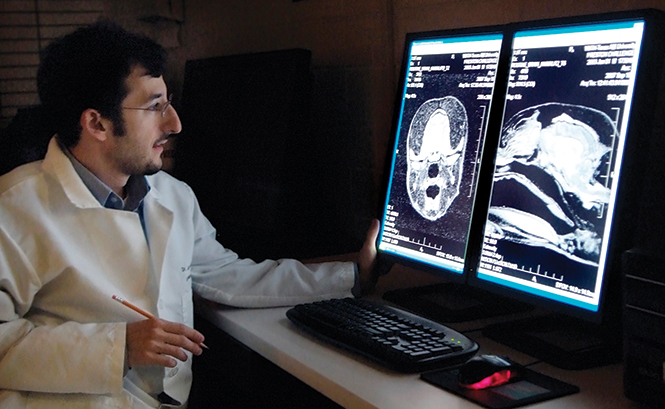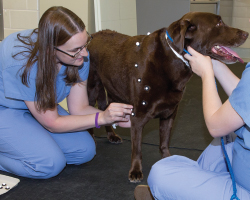Research Offers Hope for Spinal Cord Injuries: How a Clinical Trial in Dogs May Help Human Patients
How a Clinical Trial in Dogs May Help Human Patients

Dr. Jonathan Levine’s research on spinal cord injuries in dogs may one day help humans with similar injuries. The United States Department of Defense seems to think so, as they have funded a large-scale, three-year clinical trial of dogs with injuries resulting from intervertebral disc herniation. While humans with spinal cord injuries (SCIs) usually sustain these due to trauma, canine disc herniation does mimic certain facets of human injury.
Importantly, canine disc herniation results in spinal cord bruising and compression, as is the case with trauma in humans. Additionally, the treatment for canine disc herniation is amazingly similar to that which is administered to humans with spinal cord trauma.
“The animals get an MRI, they get surgery, and they get rehabilitation,” said Levine, who is an associate professor in the Department of Small Animal Clinical Sciences at the Texas A&M College of Veterinary Medicine & Biomedical Sciences.
Using dogs with naturally occurring neurological conditions, as opposed to rodents with induced injuries, gives a much more realistic view of how a drug might perform in humans. However, the study is also much more complicated because the researchers don’t have control over a number of factors. Unlike rodents, dogs vary widely in their genetics, the location and severity of the injury, and time before treatment begins. Human SCIs, of course, have similar variability.
“If a drug doesn’t work on dogs, that is a good indication that it might not work in humans either,” Levine said. On the other hand, of course, something that does work well in dogs is very promising for human injuries.
One of the ways to determine if a treatment works is to measure recovery of various functions, especially movement. Using infrared cameras that can track limb movements, Levine and his team measure how normal versus injured dogs walk. Then, in separate collaborative projects with bioengineers at the University of Louisville, the team can determine which muscles are activated.
“It is a very collaborative process,” Levine said. “There are about 20 people, at a number of different institutions, who are vital to our entire program.” The study with the U.S. Department of Defense is a joint effort with investigators at UC San Francisco Medical School. Scientists at University of Louisville, Methodist Hospital, and UT Houston Medical School are participating in an array of other projects.
“Dr. Levine’s approach is a perfect example of One Health research,” said Dr. Eleanor M. Green, the Carl B. King Dean of Veterinary Medicine. “The goal of his trial is to determine how best to treat dogs with this common injury, but in so doing he is gathering valuable data that can be used to benefit future human clinical trials.”

The drug Levine and his colleagues are evaluating in the U.S. Department of Defense canine clinical trial is a type of neuro-protective therapy, meaning it is thought to protect the cord by stopping events that happen soon after injury that actually make injury worse. Specifically, the drug blocks enzymes called metalloproteinases that are released after injury. These enzymes break down the extracellular matrix and allow white blood cells into the spinal cord, which only does more damage. However, these same enzymes can be useful at later stages of injury, after the body has started the healing process and has begun to form scar tissue. When the enzymes are inhibited at later stages, the patients tend to do poorly, which is why the drug therapy has to be timed perfectly.
“If we can get to these dogs in the first 48 hours after their injury,” Levine said, “we can give this drug—and the dogs—their optimal chance.”
If you have a dog or a patient you think might be a candidate for Levine’s clinical trial, please contact Alisha Selix (aselix@cvm.tamu.edu) or Elizabeth Scanlin (escanlin@cvm.tamu.edu) at 979-845-2351.
###
For more information about the Texas A&M College of Veterinary Medicine & Biomedical Sciences, visit our website atvetmed.tamu.edu or join us on Facebook.
Contact Information
Megan Palsa
mpalsa@cvm.tamu.edu
979-862-4216
979-421-3121
